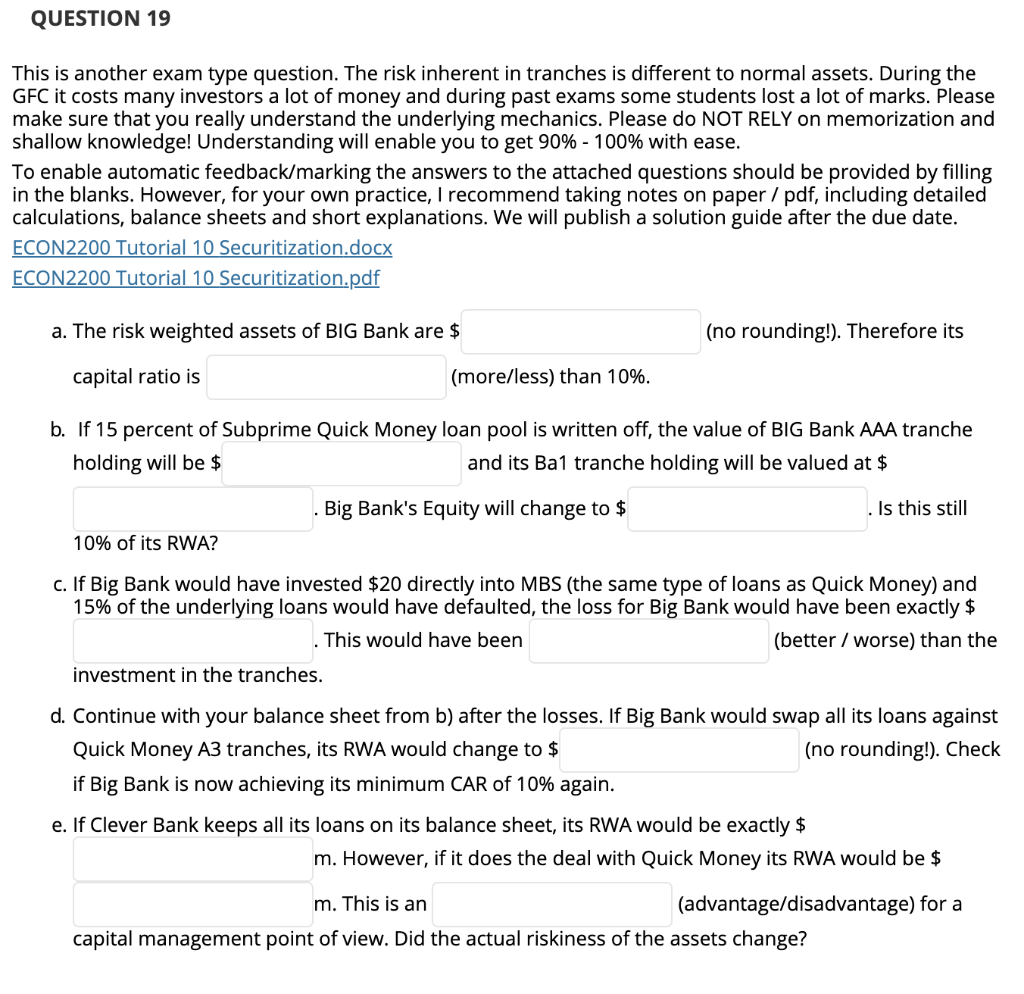
QUESTION 19 This is another exam type question. The risk inherent in tranches is different to normal assets. During the GFC it costs many investors a lot of money and during past exams some students lost a lot of marks. Please make sure that you really understand the underlying mechanics. Please do NOT RELY on memorization and shallow knowledge! Understanding will enable you to get 90% - 100% with ease. To enable automatic feedback/marking the answers to the attached questions should be provided by filling in the blanks. However, for your own practice, I recommend taking notes on paper / pdf, including detailed calculations, balance sheets and short explanations. We will publish a solution guide after the due date. ECON2200 Tutorial 10 Securitization.docx ECON2200 Tutorial 10 Securitization.pdf a. The risk weighted assets of BIG Bank are $ (no rounding!). Therefore its capital ratio is (more/less) than 10%. b. If 15 percent of Subprime Quick Money loan pool is written off, the value of BIG Bank AAA tranche holding will be $ and its Ba1 tranche holding will be valued at $ . Big Bank's Equity will change to $ Is this still 10% of its RWA? c. If Big Bank would have invested $20 directly into MBS (the same type of loans as Quick Money) and 15% of the underlying loans would have defaulted, the loss for Big Bank would have been exactly $ This would have been (better / worse) than the investment in the tranches. d. Continue with your balance sheet from b) after the losses. If Big Bank would swap all its loans against Quick Money A3 tranches, its RWA would change to $ (no rounding!). Check if Big Bank is now achieving its minimum CAR of 10% again. e. If Clever Bank keeps all its loans on its balance sheet, its RWA would be exactly $ m. However, if it does the deal with Quick Money its RWA would be $ m. This is an (advantage/disadvantage) for a capital management point of view. Did the actual riskiness of the assets change? QUESTION 19 This is another exam type question. The risk inherent in tranches is different to normal assets. During the GFC it costs many investors a lot of money and during past exams some students lost a lot of marks. Please make sure that you really understand the underlying mechanics. Please do NOT RELY on memorization and shallow knowledge! Understanding will enable you to get 90% - 100% with ease. To enable automatic feedback/marking the answers to the attached questions should be provided by filling in the blanks. However, for your own practice, I recommend taking notes on paper / pdf, including detailed calculations, balance sheets and short explanations. We will publish a solution guide after the due date. ECON2200 Tutorial 10 Securitization.docx ECON2200 Tutorial 10 Securitization.pdf a. The risk weighted assets of BIG Bank are $ (no rounding!). Therefore its capital ratio is (more/less) than 10%. b. If 15 percent of Subprime Quick Money loan pool is written off, the value of BIG Bank AAA tranche holding will be $ and its Ba1 tranche holding will be valued at $ . Big Bank's Equity will change to $ Is this still 10% of its RWA? c. If Big Bank would have invested $20 directly into MBS (the same type of loans as Quick Money) and 15% of the underlying loans would have defaulted, the loss for Big Bank would have been exactly $ This would have been (better / worse) than the investment in the tranches. d. Continue with your balance sheet from b) after the losses. If Big Bank would swap all its loans against Quick Money A3 tranches, its RWA would change to $ (no rounding!). Check if Big Bank is now achieving its minimum CAR of 10% again. e. If Clever Bank keeps all its loans on its balance sheet, its RWA would be exactly $ m. However, if it does the deal with Quick Money its RWA would be $ m. This is an (advantage/disadvantage) for a capital management point of view. Did the actual riskiness of the assets change







